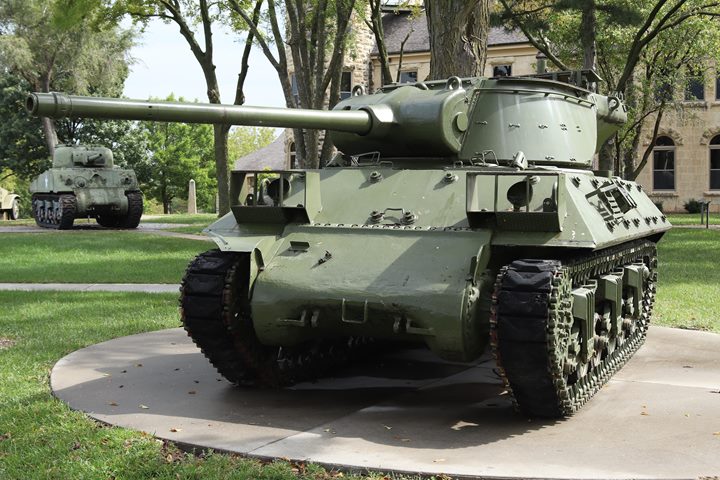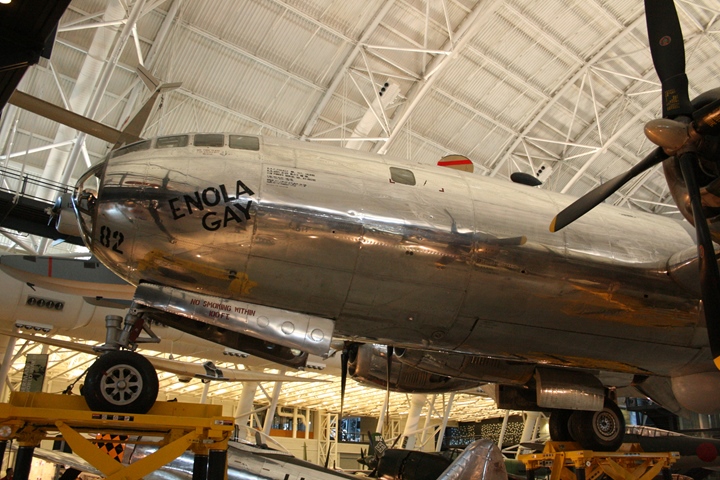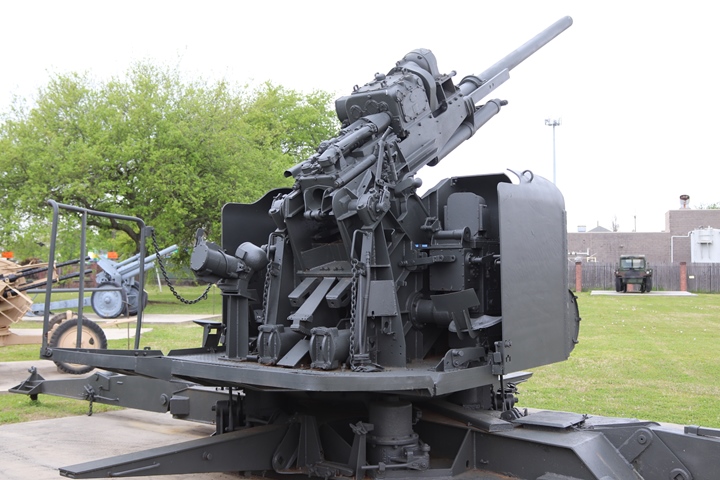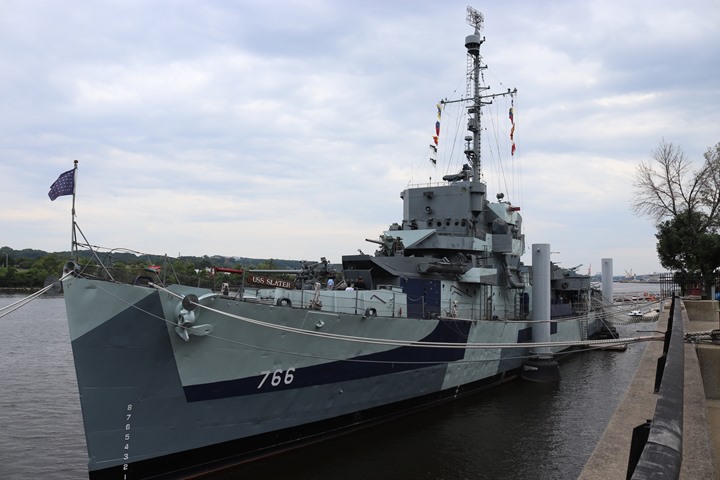|
The American
Auto Industry in World War Two
An Overview
See the "Revisions" page for my new and updated information as it is added.
This
page updated 4-18-2020.

There is no greater testament to the US
Automobile Industry's contribution to help win World War Two than this
Fisher Body Grand Blanc Tank Arsenal-built M4A3 Sherman Tank combat
veteran, on display in downtown Bastogne, Belgium. It was knocked
out of combat during one of the most famous battles of World War
Two, the Battle of the Bulge, on December 30, 1944.
It was fighting with B Company, 41st
Tank Battalion, 11th Armored Division when it was put out of action near
Renuamont, Belgium. It had been named "Barracuda" by its crew. It
sits at the intersection of several roads in Bastogne that made the town
an important military objective during the battle. The town has
been completely rebuilt since the war. German artillery fire
virtually leveled the town in attempting to drive out the American
soldiers defending it. The tank has been on display since 1948.
Author's photo.
The Purpose of this
Website: The purpose of
this website is to bring together in one location that which the US
Automobile industry produced during the Second World War. What the
products were, which company made them, the numbers produced, and their
manufacturing locations. At the beginning of World War Two, there were
twelve auto makers left in the United States, down from the hundreds
that had been producing auto early in the 20th century. All twelve
are included in this website.
While there are many good
historical sources on the US auto industry in World War Two, most focus on the
Big Three and are Detroit-centric. Not only are the other nine
auto makers of the era covered in a comprehensive manner on this
website, but all of the GM Divisions of the time are also included.
General Motors had five car divisions: Buick (Flint, MI), Cadillac
(Detroit, MI), Chevrolet (Flint, MI and other locations), Oldsmobile
(Lansing, MI), and Pontiac (Pontiac, MI). GMC was the truck
division located in Pontiac, MI. The Fisher Body Division of GMC
was headquartered in Detroit but had multiple plants where each of the
car assembly plants were located. General Motors also had a host
of component divisions located in such towns as Anderson, IN;
Kokomo, IN;
Dayton, OH; Flint, MI; and Lockport, NY. These plants produced
such items as starters, batteries, radios, sparkplugs, radiators, and
steering wheels. Chevrolet and Fisher Body each had over a dozen
plants, and each was as large or larger than Ford at the time, and
both were larger than Chrysler.
The format for each auto
maker, GM division, truck manufacturer, and auto supplier includes a
short history of the company, followed by a listing of items produced
during the war, with production numbers, if available.
Contemporary photos of the products are used for the most part instead
of historical photos.
Overview:
The U.S. auto industry produced 20% of the total U.S. output of the
material manufactured to fight World War Two, with the total value of
goods produced by the U.S. automobile industry in the war effort
surpassing $29 billion. GM produced $12 billion of that or 41% the
industry output and 8% of the entire American war economy. Ford
came in second with $3.9 billion, and Chrysler was right behind with
$3.5 billion in war contracts. Willys-Overland had $7.34 million for the
nineteen wartime projects it had. While
the auto companies were the logical manufacturers of trucks, armored
cars, jeeps and tanks, their wartime product lines were extensive, and many of the
items built were new to the industry. Both Ford and General Motors
built entire warplanes for the conflict, and many aircraft
components were produced by the industry.
Below are a few of the items
produced by the auto industry during World War Two. Some are
readily associated with the industry, while others are totally
unassociated with what the industry commonly produced at that time.

The American Auto Industry produced all of the
fully tracked tank destroyers during World War Two. Here are three of the
most important ones, as seen at the Virginia Museum of Military Vehicles
at Nokesville, VA. On the left is a Fisher Body Grand Blanc, MI
produced M10 Wolverine. In the center is an M18 Hellcat built in
Flint, MI by the Buick Motor Car Division of GM. On the end is an M36. This originally was built as
an M10A1 Wolverine at either
Ford's Highland Park, MI plant, or Fisher Body's Grand Blanc, MI tank
arsenal. It was later converted into the
M36 which replaced the 3-inch main gun with a more powerful 90mm cannon.
Author's photo.

Two American automotive industry products in the same photo. An M36
built on a Ford M10A1 chassis is in the foreground, and a Fisher Body
M4A3(75) is in the background. Of the 39 M36s still known to
existence in the world, only two have been positively identified as
being built on a Ford M10A1 chassis. Author's photo taken at the
US Cavalry Museum at Fort Riley, KS added
4-27-2018.

The nose section of the B-29 "Enola Gay".
This is one of the most famous, or infamous aircraft of all time, being
the first bomber to drop a nuclear weapon. The B-29 is not a World
War Two
weapon that one would normally associate with the American auto
industry. The eighteen foot long nose section of the fuselage that
has the name "Enola Gay" painted on it was built by Chrysler DeSoto
Division in Detroit, MI. Author's photo.

With the exception of the wing center
section, all of the other major wing, fuselage, and control surface
sections in the Enola Gay were built by the US Auto Industry. These companies were
Briggs, Chrysler, Firestone, Hudson, Goodrich, Goodyear, and
Libby-Owens-Ford. Several Fisher Body Divisions, along with
seventeen component divisions of GM, supplied parts. Dodge
supplied the engines. For the complete story, please see the
dedicated B-29 page above. Author's photo.

This JB-2 "Loon" cruise missile is another
weapon one would not associate with the American Auto Industry. Willys-Overland,
better known for its production of Jeeps during WWII, built America's
first cruise missile in Toledo, OH under contract from Republic
Aviation. The engine was built by the Ford Motor Car Company.
The JB-2 was a reverse engineered copy of the German V-1 "Buzz Bomb".
It was intended for use by the US Navy in the invasion of Japan.
Author's photo.

Pontiac Motor Car Division built aerial
launched torpedoes at its facilities in Pontiac, MI. Pontiac's
plant 11, which manufactured the torpedoes, was the first American automaker
to receive the Navy "E" award in January 1942. Author's photo.

The Eastern Aircraft Division of General Motors built the navy torpedo
bombers to carry the Pontiac-built torpedoes. Eastern Aircraft
built 7,546 TBMs during World War Two. Eastern also built 1,060
FM-1 and 4,777 FM-2 fighters for the navy. Author's photo taken at the Liberty Aviation
Museum.

This is a SCR-584 anti-aircraft radar unit
is another unusual product not typically identifiable with the American Auto Industry. Chrysler produced 2,098 radar
antenna mounts and parabolic antennas; and then installed them in
the ten-ton Fruehauf built trailer. The radar antenna mount is
stowed inside the trailer for travel. It dropped straight down to
where the table and mannequin are located. Note the cables on the
wall have slack in them, to allow for the up and down movement of the
antenna unit. This photo was taken at the National Electronics
Museum in the Baltimore, MD area, which exhibits a history of the former
Westinghouse Electronics Division (now Northrop-Grumman) located in the
area. Westinghouse installed the electronics within the trailer
after receiving it from Chrysler. Author's photo added 10-7-2016.

When World War Two ended, Nash-Kelvinator
had built more helicopters than the American aviation industry. It
built the most advanced Sikorsky Helicopter design of the war, the R-6A
Hoverfly II, which can be seen at the National Museum of the US Air
Force in Dayton, OH. Author's photo.

All American-built PT boats were powered by
three Packard 4M2500 marine engines which had Delco-Remy starters and DC
generators and Harrison Radiator heat exchangers. The 60mm mortar
on the bow could have a Firestone Tire and Rubber company base plate.
Pontiac built 20mm Oerlikon cannons like the one on the bow of PT-305.
Other PT boats were equipped with Oldsmobile 37mm cannons. The AC Spark
Plug and Frigidaire Divisions of GM built .50 caliber machine guns.
This Higgins Industries-built 78 foot PT boat is the only World War Two
combat veteran still in existence. The author's photo was taken in
the PT-305 boat house on Lake Pontchartrain in New Orleans, LA operated
by the National WWII Museum. Photo added 4-27-2018.

The 40mm gun mount on the stern of PT-305
was built by Firestone. Chrysler and Pontiac both built gun
mechanisms and gun tubes for weapons like this. Author's photo
added 4-27-2018.

The American Automobile Industry was a major
source of anti-aircraft guns for both the army and navy during World War
Two. The Fisher Body Plant in Pontiac, MI built 2,359 90mm
anti-aircraft guns like this one. Three Fisher Body plants
provided tooling to make parts and another three plants provided parts
for the big guns. Chevrolet built 2,000 gun tubes, breech ring and
blocks, and recoil rails for the weapon. Buick built 2,952 gun
mounts. It was a truly a General Motors corporate endeavor.
Author's photo added 4-18-2020.

The USS Slater is the only Cannon Class
Destroyer Escort on display in the world, and is located on the Hudson
River in downtown Albany, NY. The 72 Cannon Class DEs had four Cleveland Diesel
Division of GM diesel
engines driving generators which provided power to four electric motors
for main propulsion, and four more for
ship's electrical power. The USS Slater also has a 3-inch gun with a
Fisher Body breech, 20mm Oerlikon cannons and gun mounts built by Pontiac, and heat exchangers
for the main engines built by the Harrison Radiator Division of GM.
The 97 ships in the Evarts class of DEs had the same compliment of
Cleveland Diesel engines. Author's photo added 10-29-2017.

Graham-Paige built LVT-1's, like this one
displayed in the main lobby of the National Museum of the USMC in
Quantico, VA. Reo Motor Car Company built the bogies for the LVT
series of tracked landing craft. This diorama depicts the LVT-1 going over a log
barrier on Tarawa. Author's photo.

Yes, this is a photo of a replica of the
first atomic bomb dropped during World War Two. It is located at the
National Museum of the US Air Force. Chrysler delivered 1,000
railroad cars of equipment for the diffusion using hexafluoride gas to
separate U-235 from U-238 at Oak Ridge, TN (The Secret City) during
World War Two. Author's photo.

The Cleveland Diesel Division of General
Motors of Cleveland, OH supplied half of the diesel engines installed in
the US submarine fleet of World War Two. Today the World War Two era submarine USS
Cod can be seen along the waterfront in Cleveland, OH. One of the
four Cleveland Diesels Engines on the submarine is operational. Author's photo.

The Bofors 40mm cannon gun mount on the deck of the USS Cod
was built by Firestone Tire and Rubber Company. Author's photo.
Last website revision date: 7-6-2025
Original publication date: 8-30-2013
|

















